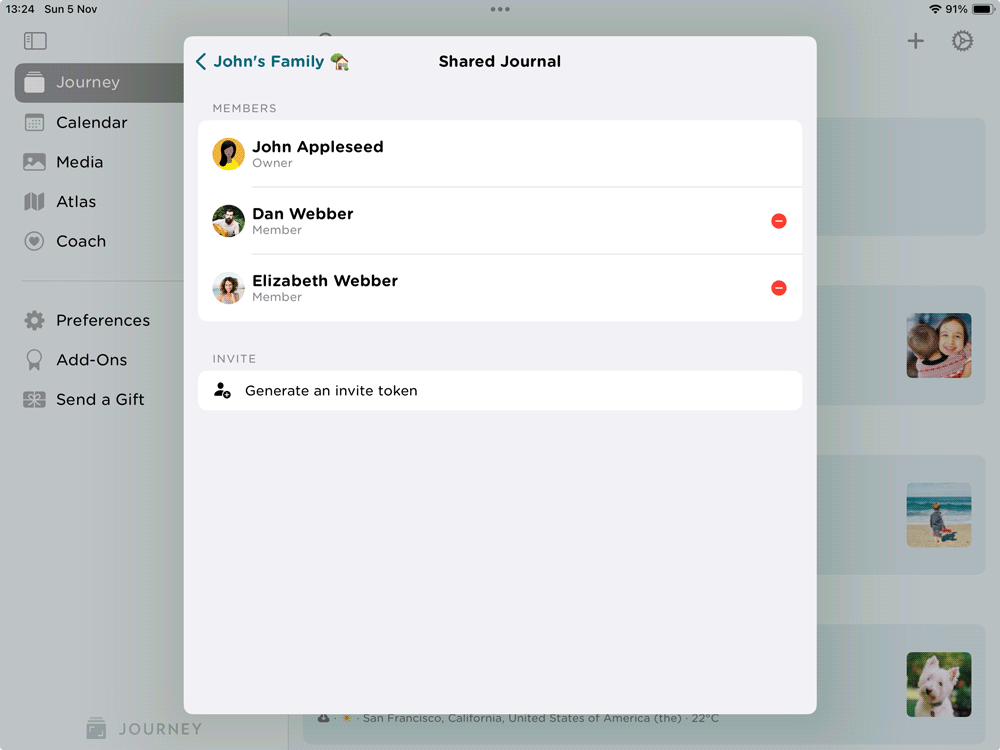Shared Journals - How Shared Journaling Can Add Value to your Relationships
Using shared journals is a fun and important way to connect with loved ones. By writing and sharing thoughts, feelings, and experiences, you can understand each other better and improve your relationship. Find out how to start a shared journal with your partner or friend by reading this blog.

In our fast-paced digital world, where time moves in the blink of an eye and communication often becomes fragmented, there are still ways in which we can cope with the boundaries of time and distance to create a profound sense of connection and growth among ourselves. As humans, we are naturally drawn to storytelling, seeking to share our experiences, thoughts, and emotions with others. The shared journal, an age-old concept rejuvenated by modern technology, offers a sacred space for individuals to embark on a collective journey of self-expression, empathy, and understanding.
Read on to find out more about what a shared journal is, its applications in our daily lives, and the benefits it brings to both individuals and communities.
What is a Shared Journal?
A shared journal is a collaborative writing document or diary that is accessible to multiple people. It allows multiple individuals to contribute, share thoughts, feelings, experiences, and ideas within the same journal, creating a shared space for communication and reflection. Unlike traditional journals or diaries that are typically private and meant for individual use, a shared journal invites multiple participants to share their entries and interact with each other's content.

This concept of shared journaling is often utilized in various settings, including personal relationships, group projects, therapy sessions, and even within certain digital platforms or apps. Participants who have access to the shared journal can read, write, and engage with the content whenever they want, making it easy to stay connected and engaged. It provides a platform for individuals to express themselves openly, communicate with others, and engage in meaningful discussions.
Benefits of keeping a Shared Journal
Keeping a shared journal with others can offer a multitude of benefits, enhancing personal growth, building stronger relationships, and fostering a sense of community. These benefits include:
1. Improved Communication
Photo by Priscilla Du Preez 🇨🇦 / Unsplash
Sharing a journal creates a platform for open and honest communication. Participants can express their thoughts, feelings, and experiences in a safe space, promoting meaningful conversations. Writing in a shared journal encourages individuals to articulate their thoughts and emotions clearly. As they share their experiences, feelings, and ideas with others, they become more adept at expressing themselves effectively. Expression requires active engagement with others' entries, creating a habit of attentive and responsive communication.
2. Strengthening Relationships
In relationships, whether they are romantic, familial, or friendships, sharing a journal can lead to increased intimacy and understanding. It allows participants to connect on a deeper level by sharing their innermost thoughts and emotions. Shared journals also become a collective repository of memories and reflections. Participants can look back on their journey together, noting growth and progress over time.
Photo by David Dvořáček / Unsplash
Interacting with diverse emotions in the shared journal can enhance emotional intelligence, enabling individuals to better recognize and manage emotions in themselves and others. Engaging with the perspectives and experiences of others in the shared journal also cultivates empathy. Expressing gratitude or appreciation for each other's entries and contributions in the shared journal reinforces positive sentiments within the relationship. Participants also get the chance to gain insight into different viewpoints, leading to a greater appreciation of each other's feelings and struggles.
3. Sense of Community
In group settings like support groups or team projects, a shared journal creates a sense of belonging and solidarity. Participants can share their challenges, triumphs, and support one another. Sharing personal thoughts and experiences in a safe space also builds trust within the group. As individuals trust that their feelings will be respected and understood, they become more open to sharing and connecting.
During challenging times, a shared journal offers a communal support system, where participants can find comfort and encouragement from others who may have faced similar situations.
4. Celebrating Milestones Together
In a shared journal, participants can document their personal achievements and milestones. Whether it's reaching a fitness goal, landing a dream job, or completing a significant project, recording these milestones serves as a testament to their growth and accomplishments.
Photo by Priscilla Du Preez 🇨🇦 / Unsplash
When participants share their milestones in the journal, others can celebrate these achievements with them. This shared joy and support create a positive and uplifting environment, reinforcing the sense of camaraderie within the group. Celebrating milestones in a shared journal ensures that each participant's achievements are acknowledged by the entire group. This collective recognition makes the celebration even more meaningful and impactful.
When individuals share their milestones, it can inspire others in the group to set and achieve their own goals. Witnessing the success of others can ignite a sense of determination and drive within the community.
5. Stress Reduction
Writing in a shared journal provides an emotional outlet for participants to express their thoughts and feelings. This act of self-expression can help release pent-up emotions and reduce emotional stress. Participants can share their stressors and challenges in the shared journal, and the group can respond with understanding and support. Knowing that they are not alone in their struggles can provide comfort and reduce feelings of isolation.
Photo by Zach Betten / Unsplash
Putting stress-related thoughts into writing can act as a cathartic release, helping individuals process their feelings and concerns in a healthy way. If individuals express overwhelming stress in the shared journal, the group can encourage seeking professional help when necessary, emphasizing the importance of mental health support.
6. Virtual Bonding
In situations where physical proximity is not possible, such as long-distance relationships or remote work teams, a shared journal provides a way to stay connected and maintain bonds. In a virtual setting, participants may feel distant from one another. A shared journal creates a virtual space where individuals can interact, communicate, and engage in a meaningful way, bridging the gap between them.
A digital shared journal enables real-time collaboration, allowing participants to respond to each other's entries and engage in dynamic discussions, creating a sense of immediacy and connection In the absence of face-to-face interactions, the shared journal serves as a virtual socializing space, allowing individuals to connect, share stories, and enjoy each other's company.
These make a shared journal a powerful tool that encourages meaningful connections, personal growth, and mutual support. It promotes empathy, strengthens relationships, and creates a space for individuals to share their authentic selves, ultimately fostering a sense of community and well-being.
Examples of Shared Journals
1. Couples or Best Friends
Some partners or close friends maintain a shared journal to document their experiences, dreams, and emotions together. It serves as a way to enhance communication and strengthen their bond.
Photo by Annette Sousa / Unsplash
Couples or friends could use a shared journal to write gratitude entries, appreciating the little things they love and cherish about each other. This practice fosters a positive atmosphere and reinforces feelings of love and appreciation. The shared journal can also be used as a safe space to discuss sensitive topics or conflicts. Writing allows time for thoughtful expression and can lead to more constructive communication.
Couples can use the journal to jot down fun activities, date ideas, or adventures to try together. This fosters excitement and exploration in the relationship. Periodically, the couple can also write relationship check-ins to discuss how they feel about the relationship and areas they want to nurture further.
2. Family Journals
Families might keep a shared journal where members can write about their daily experiences, milestones, or plans, fostering a sense of togetherness. It would be a wonderful way to improve relationships, strengthen bonds, and foster a sense of togetherness. Here are some ways a family can utilize a shared journal to enhance their connections:
Photo by Luca Baini / Unsplash
- Encourage each family member to write regular reflections in the shared journal. These entries can be about their day, their feelings, and any significant experiences. Sharing these reflections can promote understanding and empathy within the family.
- Create a section in the shared journal for expressing gratitude. Encourage family members to write down things they are thankful for, whether it's about each other or various aspects of their lives. This practice cultivates a positive atmosphere and appreciation for one another.
- Create a family bucket list in the shared journal, with activities or adventures everyone wants to experience together. Working towards these goals fosters a shared sense of excitement and adventure.
3. Team Projects
A shared journal can be a valuable tool in team projects, both in educational and professional settings. It allows team members to collaborate, share ideas, track progress, and maintain a record of the project's development.
Here are some ways a shared journal can be used:
- Collaborative Brainstorming: Team members can use the shared journal to brainstorm ideas, solutions, and strategies for the project. Everyone can contribute their thoughts, and it serves as a centralized space for creative thinking.
- Meeting Notes and Minutes: During team meetings, the shared journal can be used to document important discussions, decisions, and action items. This ensures that all members are on the same page and have access to meeting outcomes.
- Task Management: The shared journal can be used to create a task list or a to-do list for the project. Each member can update the status of their tasks, making it easier to monitor progress and identify any bottlenecks.
- Feedback: Team members can provide feedback on each other's work through the shared journal, allowing for a transparent and constructive feedback loop.
- Remote Collaboration: In virtual or remote teams, a shared journal becomes even more critical as it provides a central space for communication and collaboration, overcoming geographical barriers.
Create a Shared Journal in Journey
Keeping a physical book as a shared journal can prove to be inconvenient as only one person would be able to hold on to it at a time. This wouldn't allow friends or family members to write in it anytime they please. Various digital platforms and mobile apps offer shared journaling features that enable users to collaborate on creative projects, express themselves, or share travel experiences with others.

If you're looking for a place to star sharing a journal with your family or friends. Journey can be a safe space that everyone can write in and contribute to. As a digital diary platform, Journey Cloud Sync "Shared Journals" is a feature that is geared towards deepening relationships, enhancing communication, and facilitating shared learning. It could also serve as a collective memory repository in which people can document shared experiences, milestones, and important events in their lives.


The security and versatility of Journey Cloud Sync ensures collaboration and fosters a sense of connection among individuals who can interact, respond, and build upon each other's entries. Individuals can contribute to a shared account and engage with it collaboratively. Individuals can view, edit, and add new journal articles to the account which can then be accessed by other members as well.
How To Create A Shared Journal in Journey
To create a shared journal on Journey:
- Under Settings in your Journey Cloud sync, head to Cloud Accounts and scroll down to "Manage".
- Under "Shared Journal", create a shared journal.
- Send the generated invite token to another person to use to join.
To join a shared journal cloud account:
- Select "Add a Cloud Account" from the top left icon of your account in the timeline.
- Click on "Add Invitation Code", paste the code that was sent to you, and click "Join".
To exit a shared journal:
- Select "Shared Journal" under "Cloud Accounts" in Settings.
- Select "Manage", and then "Shared Journal"
- Click the remove button next to your name.
A shared journal is a versatile and dynamic tool that fosters connections, encourages self-expression, and promotes open dialogue among participants, making it a powerful means of building relationships and community. Shared journals can elevate the way we communicate, connect, and grow even in the digital age. It fosters culture of open communication, empathy, and understanding. Participants learn to express themselves authentically while actively engaging with the thoughts and feelings of others. These improved communication skills extend beyond the shared journal, positively influencing participants' interactions in various aspects of their personal and professional lives.
With shared journals, you can value-add to your journey of self-discovery empathy, with genuine human connection!










